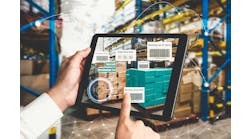Keeping Shelves Stocked at Retail Show
It was all about inventory at this year’s Retail Systems 2002 and VICS Collaborative Commerce Show and Conference, held at McCormick Place in Chicago. How to manage it, when to replenish it, how to ensure customers find what they want when they want it. One of the major problems retailers have is keeping their shelves filled with the right product, especially when product is located in their back storerooms.
That’s why so many attendees were discussing RFID and whether it could help solve this problem. RFID holds a lot of promise. But retailers have several reasons why they are holding back on implementation. Two reasons are cost and cultural changes that must occur before retailers willingly and easily share data among their supply chain partners. “It’s down to share versus sell,” said Rik Schrader, vice president of business development and marketing and sales at Aquitec. “There’s a history of competition that must be overcome.”
Several executives commented that RFID will change the retail world, assuming retailers can cooperate. RFID tags and smart tags were frequently mentioned as a way to solve the replenishment problem, providing retailers with real-time data of when a product was removed or added to a shelf. However, retailers are reluctant to spend the money necessary to implement such solutions. Even at a chip cost of five cents, many thought the price too high to invest in this technology.
The Gap Inc., though, was one company that spoke about its pilot RFID project in one of the conference sessions. It tested smart tags on denim apparel throughout its supply chain. Antennas were built into shelves at the stores. As items were removed, that data was sent to a sales associate, who would replenish the shelf as needed, noted Neco Can, director of project management at Gap.
It was an expensive pilot, yet it yielded good results. In tests, the RFID system helped improve tracking accuracy, boosting it to 99.9 percent. It also provided assistance at point-of-sale operations through mass scanning at checkout, speeded returns processing and facilitated in-store pickups of Internet orders. “It provided real-time inventory tracking, said Bill Allen, eMarketing manager of RFID systems at TI, one of the contractors of the pilot.
Another solution receiving a lot of interest, but one that will also have to overcome the resistance to data sharing, is UCCnet, developed by the Universal Product Code Council. UCCnet is not a retail exchange. The perception that it is, though, is slowing acceptance among retailers. As of the show, 101 retailers have signed on as subscribers.
UCCnet is basically a repository. Product data, such as weight, dimensions, size and color, are entered by the manufacturer into this repository. It then structures these data into a standard and consistent format for exchange between ordering systems. This “data synchronization” ensures that all trading partners use identical and accurate item information.
The benefits of the UCCnet system are that it will reduce supply chain costs associated with errant purchase orders, returned shipments, multiple item definitions, lost shelf time and other logistics system errors. It eliminates multiple manual transcriptions of the data required to support new item introductions because data are entered into the system only once. Manufacturers can either load data into the system directly or use an alliance partner. Any company can store its product information, and then distribute that information simultaneously in near real time to any number of trading partners that subscribe to UCCnet.
Wal-Mart is one of the largest corporate supporters of this system. Said Randy Salley, vice president of merchandising systems at Wal-Mart Stores Inc., “It’s all about standards.” The company has 18,000 suppliers that it’s urging to subscribe.
And, lastly, biometrics for point-of-sale applications is emerging from pilot applications and into actual use. Representatives of Indivos, one of the suppliers of this technology, discussed several retail implementations, primarily in the northwest sections of the country. Biometric POS systems are popular with retired shoppers, as they don’t have to carry cash. Instead, they can select their purchases, place their index finger in the finger scanner and pay for the purchases that way. The system stores credit card information associated with the digitized fingerprint in a secure format. Retailers like it because it reduces the number of invalid charges.
— Leslie Langnau, senior technical editor


